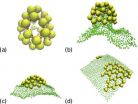(Press-News.org) October 24, 2012, New York, NY – Cancers arise in the body all the time. Most are nipped in the bud by the immune response, not least by its T cells, which detect telltale molecular markers—or antigens—on cancer cells and destroy them before they grow into tumors. Cancer cells, for their part, evolve constantly to evade such assassination. Those that succeed become full-blown malignancies. Yet, given the right sort of help, the immune system can destroy even these entrenched tumors.
In the October 22nd issue of the Journal of Experimental Medicine, researchers led by Jedd Wolchok, MD, PhD, of the Ludwig Center for Cancer Immunotherapy at Memorial Sloan-Kettering Cancer Center (MSKCC) in New York describe one way in which that might be achieved. The paper relates how the cancer drug cyclophosphamide (CTX) and OX86—an antibody that activates a molecule named OX40 on T cells—were combined with a cutting-edge therapy known as adoptive T cell transfer to eradicate advanced melanoma tumors in mice.
Wolchok and his colleagues had previously shown that CTX and OX86 treatment caused the regression of such tumors. Now they wanted to see if adding T cell transfer to the mix would further improve outcomes. T cell transfer is an investigative immunotherapy in which T cells that target tumors are isolated from patients, manipulated, expanded and then transfused back into those patients.
A variety of T cells are of relevance to this approach. One is the CD8+ T cell, which can directly kill diseased and cancerous cells. Another is the CD4+ T cell, whose general role is to orchestrate the immune assault. It comes in several varieties — examples are the T helper 1 (Th1) and T helper 2 (Th2)—each of which elicits a distinct sort of immune response. And then there is the regulatory T cell, which keeps a lid on the last two responses.
The activation of OX40 on T cells has varying effects. "When OX40 is activated on regulatory T cells in the tumor, they get so stimulated that they actually die," explains Wolchok. Other CD4+ T cells, on the other hand, step up the immune attack following OX40 activation.
To harness that phenomenon, Wolchok's team transplanted melanoma tumors into mice and allowed them to grow until they got to be about as advanced as permitted. They then gave the mice CTX and OX86, waited a day and transfused them with T helper cells engineered to target a tumor antigen known as Trp1.
The results were as surprising as they were swift: tumors expressing the Trp1 antigen didn't just get smaller. They were eradicated. What's more, the combination therapy also destroyed tumors composed of a mix of cells that display the Trp1 antigen and those that do not. This is significant because most human tumors are built from such mixed populations of cells.
"These T cells are so exquisitely tuned," says Wolchok, "that they induce collateral damage to cells in the tumor that don't even express the targeted antigen."
Wolchok and his colleagues discovered that OX40 activation dramatically altered the transfused T helper cells. They remained CD4+ T cells, yet became capable of destroying cancer cells themselves. Further, they took on traits common to long-lived memory cells, which ensure that any future tumors expressing the targeted antigen are quickly destroyed. Finally, these entirely novel T cells also had qualities of both Th1 and Th2 subtypes of T helper cells. This might explain how they induced an anti-tumor response vigorous enough to kill tumor cells that did not even bear the antigen they were targeting.
"This is not just of academic interest," says Wolchok, pointing out that most T cell transfer studies have so far focused on CD8+ T cells. "If these killer-memory CD4+ T cells are the ones that are really important to tumor killing then they are the ones we should be trying to transfer."
Further, combining other immunotherapies with OX40-stimulation could by itself boost T cell activity against tumors to significant effect. "Ideally," says Wolchok, "if one could make the endogenous immune response sufficiently robust, you might not need to do the adoptive transfer."
That idea could soon be put to the test. Ludwig and the Cancer Research Institute signed an agreement with MedImmune, the global biologics arm of AstraZeneca, that will enable the examination of the clinical effects of an OX40-activating antibody as well as two other antibodies that disrupt the suppression of immune responses by tumors.
The new findings on how OX40 activation affects T helper cells will doubtless inform those studies.
###
This work was supported by grants from the National Cancer Institute (R01CA56821, P01 CA33049, and P01 CA59350), Swim Across America, the Lita Annenberg Hazen Foundation, the T.J. Martell Foundation, the Mr. William H. Goodwin and Mrs. Alice Goodwin and the Commonwealth Cancer Foundation for Research, and the Experimental Therapeutics Center of Memorial Sloan-Kettering Cancer Center.
About the Ludwig Institute for Cancer Research
The Ludwig Institute is an international non-profit organization committed to improving the understanding and control of cancer through integrated laboratory and clinical discovery. Leveraging its worldwide network of investigators and the ability to sponsor and conduct its own clinical trials, the Institute is actively engaged in translating its discoveries into applications for patient benefit. Since its establishment in 1971, the Institute has expended more than $1.5 billion on cancer research. http://www.licr.org
For further information please contact:
Ludwig Institute for Cancer Research, Rachel Steinhardt, rsteinhardt@licr.org or +1-212-450-1582
Mouse model exposes a new type of T cell to target melanoma
2012-10-24
ELSE PRESS RELEASES FROM THIS DATE:
A new take on the Midas touch -- changing the color of gold
2012-10-24
Red gold, green gold – a ground-breaking initiative has found a way of changing the colour of the world's most iconic precious metal.
A University of Southampton team have discovered that by embossing tiny raised or indented patterns onto the metal's surface they can change the way it absorbs and reflects light – ensuring our eyes don't see it as 'golden' in colour at all.
The finding results from a major initiative funded by the Engineering and Physical Sciences Research Council (EPSRC) targeting the development of a new generation of nanotechnology-enabled materials. ...
The majority of roadkill amongst vertebrates in Catalonia are in protected areas
2012-10-24
Amphibians are the vertebrate group that is more likely to become roadkill in Catalonia, even more so than reptiles, mammals and birds. This is the case according to an international team of scientists who have concluded that highly protected areas are home to more cases of animal death on the roads.
Our network of roads is considered one of the main threats to fauna survival. Researchers at the universities of Barcelona (UB), Porto (Portugal) and Uppsala (Sweden) have studied the number of vertebrate deaths on 820 kilometres of road in North Eastern area of Spain and ...
New insights into membrane-assisted self-assembly
2012-10-24
"In our current paper we present new computational results that explore how membranes may influence crucial biological processes", explains Richard Matthews, Lise-Meitner-Fellow at the University of Vienna and first author of the study. The focus of the investigation is the self-assembly of microscopic particles, the formation of structures or patterns without human intervention. More specifically, the effect of the interactions between membranes and proteins, which can influence the formation of ordered structures in cells, is considered.
Self-assembly has become a hot ...
Study: Flame retardant 'Firemaster 550' is an endocrine disruptor
2012-10-24
The flame-retardant mixture known as "Firemaster 550" is an endocrine disruptor that causes extreme weight gain, early onset of puberty and cardiovascular health effects in lab animals, according to a new study spearheaded by researchers from North Carolina State University and Duke University.
Firemaster 550 is made up of four principal component chemicals and is used in polyurethane foam in a wide variety of products, ranging from mattresses to infant nursing pillows. The flame-retardant mixture was developed by Chemtura Corp., and was first identified by the research ...
Voice prostheses can help patients regain their lost voice
2012-10-24
Help is on the way for people who suffer from vocal cord dysfunction. Researchers are developing methods that will contribute to manufacturing voice prostheses with improved affective features. For example, for little girls who have lost their voices, the improved artificial voice devices can produce age-appropriate voices, instead of the usual voice of an adult male. These advances in artificial voice production have been made possible by results achieved in a research project led by Professor Samuli Siltanen, results that are good news indeed for the approximately 30,000 ...
Unearthing a hidden dietary behavior
2012-10-24
Though it was identified as a disorder as early as the 14th century, pica, or the eating of non-food items, has for years believed to be all but non-existent in a few corners of the globe – a 2006 study that reviewed research on pica found just four regions – the South of South America, Japan, Korea and Madagascar –where the behavior had never been observed.
A new Harvard study, however, is showing that pica – and particularly geophagy, or the eating of soil or clay, is far more prevalent in Madagascar, and may be more prevalent worldwide, than researchers previously ...
Hypnosis helps hot flashes
2012-10-24
CLEVELAND, Ohio (October 24, 2012)—Hypnosis can help cut hot flashes by as much as 74%, shows a study supported by the National Center for Complementary and Alternative Medicine. This is the first controlled, randomized study of the technique to manage hot flashes, which affect as much as 80% of women who go through menopause. The study was published online this month in Menopause, the journal of the North American Menopause Society.
Controlled, randomized studies may pit an active drug against an inactive placebo pill. But it's hard to find a placebo for mind-body techniques. ...
Brainwave training boosts network for cognitive control and affects mind-wandering
2012-10-24
A breakthrough study conducted in Canada has found that training of the well-known brainwave in humans, the alpha rhythm, enhances a brain network responsible for cognitive-control. The training technique, termed neurofeedback, is being considered as a promising new method for restoring brain function in mental disorders. Using several neuroimaging methods, a team of researchers at the Western University and the Lawson Health Research Institute have now uncovered that functional changes within a key brain network occur directly after a 30-minute session of noninvasive, ...
Earth's magnetosphere behaves like a sieve
2012-10-24
ESA's quartet of satellites studying Earth's magnetosphere, Cluster, has discovered that our protective magnetic bubble lets the solar wind in under a wider range of conditions than previously believed.
Earth's magnetic field is our planet's first line of defence against the bombardment of the solar wind. This stream of plasma is launched by the Sun and travels across the Solar System, carrying its own magnetic field with it.
Depending on how the solar wind's interplanetary magnetic field – IMF – is aligned with Earth's magnetic field, different phenomena can arise ...
An eye for an eye, a tooth for a tooth
2012-10-24
This press release is available in German.
It all began with a harmless game of soccer among young men in northwestern Albania. After one of the players had been injured in a subsequent dispute, his team members shot a relative of the suspected attacker. Now the male members of the families involved in the blood feud do not dare leave their homes. Such vendettas and blood feuds occur in many societies, sometimes lasting for decades. The harm for the participants is enormous and lacks apparent benefit, as the participants often no longer remember what actually triggered ...


